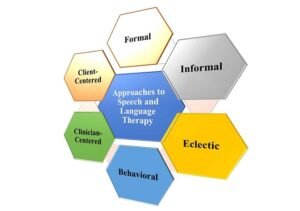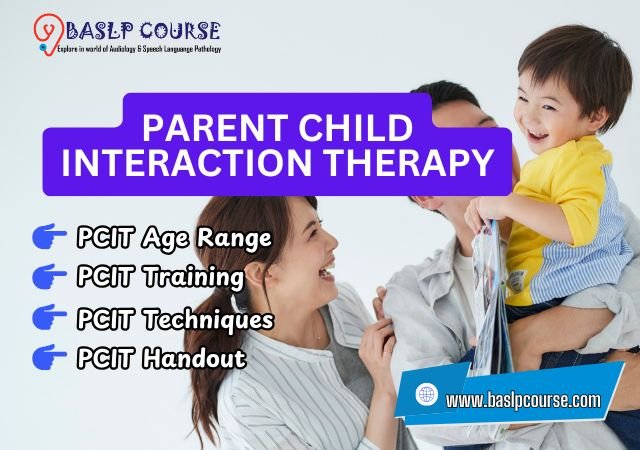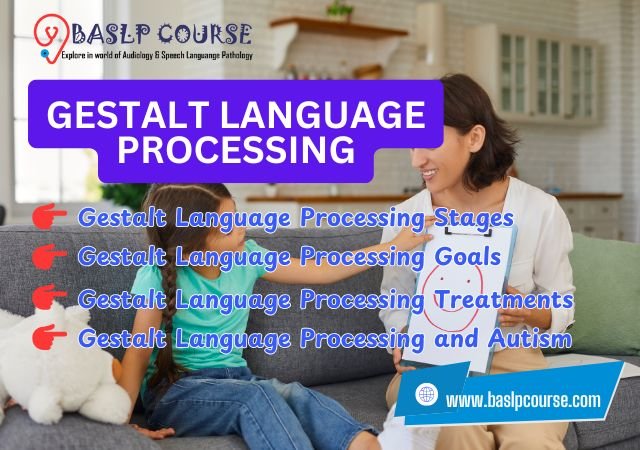
Approaches to Speech and Language Therapy – Formal Informal and Eclectic: Speech and language disorders can significantly impact an individual’s ability to communicate effectively. This leads to various challenges in personal, academic, and professional aspects of life. Speech and language therapy is a specialized field that aims to address these challenges. Secondly, help individuals improve their communication skills. There are different approaches to Speech Language Therapy. Each therapy offers unique methodologies. In addition, techniques to support clients in overcoming their speech and language difficulties.
Formal approaches provide evidence-based techniques. While informal approaches create a comfortable and natural environment for practice. Eclectic therapists blend methodologies to design personalized interventions, and behavioral approaches use reinforcement to shape behaviors effectively. Clinician-centered and client-centered approaches emphasize the role of the therapist and the client, respectively. By all means, the most effective approach depends on the individual’s specific needs and goals.
Formal Approaches to Speech and Language Therapy
Formal approaches to speech and language therapy involve structured and evidence-based methods that follow a predetermined set of techniques and activities. These methods are typically grounded in scientific research and are widely accepted within the professional community. As a matter of fact, formal approaches often rely on standardized assessment tools to diagnose specific speech and language disorders accurately.
- Applied Behavior Analysis (ABA): ABA is a widely recognized formal approach to SLT, particularly for individuals with autism spectrum disorders. It focuses on reinforcing positive behaviors and reducing negative behaviors through systematic observation and data analysis.
- Prompting Techniques: This formal approach utilizes prompts, such as visual, verbal, or gestural cues, to encourage correct speech and language responses. It is especially effective for individuals with articulation or phonological disorders.
- Linguistic Approaches: Linguistic-based formal approaches firstly, target language aspects, such as syntax, morphology, and semantics. Secondly, therapy sessions focus on enhancing grammatical structures and vocabulary to improve overall language comprehension and expression.
Informal Approaches to Speech and Language Therapy
Informal approaches to speech and language therapy encompass a more relaxed and naturalistic approach because incorporate everyday interactions and activities to improve communication skills. These approaches aim to create a comfortable environment for clients, promoting spontaneous communication.
- Play-Based Therapy: Particularly effective for children, play-based therapy involves using toys, games, and creative activities to encourage language development and social interaction.
- Storytelling and Narratives: This informal approach involves engaging clients in storytelling, role-playing, and creating narratives to enhance their language comprehension and storytelling abilities.
- Conversation-Based Therapy: This approach focuses on meaningful conversations and real-life communication scenarios to help clients apply their speech and language skills in practical situations.
Eclectic Approaches to Speech and Language Therapy
Eclectic approaches to speech and language therapy combine elements from both formal and informal methods. Therapists who adopt this approach tailor their techniques based on the individual needs and goals of the client. By drawing from various methodologies, eclectic therapists can create personalized and effective intervention plans.
- Individualized Treatment Plans: Eclectic therapists conduct thorough assessments and design unique treatment plans that blend different strategies to address specific speech and language challenges.
- Task-Specific Approaches: This approach involves breaking down communication tasks into smaller, manageable steps and using a combination of formal and informal techniques to achieve successful outcomes.
- Technology Integration: Eclectic therapists may leverage technology and educational apps to supplement their therapy sessions, providing clients with interactive and engaging tools for practice and reinforcement.
Behavioral Approaches to Speech and Language Therapy
Behavioral approaches to speech and language therapy focus on modifying behavior through positive reinforcement, prompting, and shaping techniques. These approaches are highly structured and rely on data collection and analysis to track progress.
- Positive Reinforcement: The use of positive reinforcement, such as praise, rewards, or tokens, is common in behavioral approaches to motivate clients to exhibit desired speech and language behaviors.
- Token Economy Systems: Generally, therapists implement token economy systems, where clients earn tokens for desired behaviors, which can later be exchanged for rewards or privileges.
- Visual Supports: Behavioral approaches often utilize visual supports, like schedules or charts, to aid comprehension and provide clear communication cues.
Clinician-Centered Approaches to Speech and Language Therapy
Clinician-centered approaches place the therapist in a more directive role during therapy sessions. These approaches involve the therapist leading the interactions and structuring the activities.
- Direct Instruction: In clinician-centered approaches, the therapist provides direct instruction and guidance to the client throughout the session.
- Drill-Based Practice: This method involves repetitive and structured drills to target specific speech sounds or language skills.
- Prompt Hierarchy: Clinician-centered approaches may use a prompt hierarchy.Where the therapist gradually increases or decreases the level of support provided based on the client’s response.
Client-Centered Approaches to Speech and Language Therapy
Client-centered approaches prioritize the client’s preferences, interests, and communication needs. Therapists adopting this approach actively involve clients in setting goals and choosing therapy activities.
- Person-Centered Planning: Clients actively participate in the goal-setting process, and therapy activities align with their personal interests and motivations.
- Choice-Making Opportunities: Therapists offer clients choices during sessions to empower them and promote active engagement in the therapy process.
- Collaborative Decision-Making: Client-centered therapists work closely with clients and their families to co-create therapy plans that align with the client’s individual strengths and needs.
Hybrid Approaches to Speech and Language Therapy
Hybrid approaches to speech and language therapy integrate elements from different theoretical frameworks. Further blending formal, informal, behavioral, and client-centered strategies.
- Holistic Treatment Plans: Hybrid approaches focus on addressing the whole individual, considering their unique communication challenges, strengths, and preferences.
- Flexibility and Adaptability: Therapists utilizing hybrid approaches remain flexible and adaptable.Coupled with tailoring therapy methods based on the client’s progress and changing needs.
- Integrated Goals: These approaches integrate various therapy goals to target multiple aspects of speech and language simultaneously.
Conclusion
Different strategies are used in the field of speech and language therapy to meet the specific requirements of people who struggle with communication. There is a broad range of options available, including formal methods based on scientific research, informal approaches emphasizing the creation of a comfortable environment, eclectic therapists who blend various techniques, behavioral approaches emphasizing positive reinforcement, and client-centered strategies that empower the individual. The client’s unique needs and goals will determine which strategy works best. Individuals who struggle with communication can enjoy more fulfilled lives and actively participate in all facets of life—personal, intellectual, and professional—with the assistance of speech and language therapy.
Frequently Asked Questions
What is speech and language therapy?
- Speech and language therapy is a specialized field aimed at helping individuals with speech and language disorders improve their communication skills.
What are formal approaches to speech and language therapy?
- Formal approaches are evidence-based methods that follow structured techniques and activities. They often rely on standardized assessment tools for diagnosis and are grounded in scientific research.
What are some examples of formal approaches in speech and language therapy?
- Examples include Applied Behavior Analysis (ABA), prompting techniques, and linguistic approaches that target various aspects of language.
What are informal approaches to speech and language therapy?
- Informal approaches create a natural and comfortable environment for practice, often using everyday interactions and activities to enhance communication skills.
Can you provide examples of informal approaches in speech and language therapy?
- Examples include play-based therapy, storytelling and narratives, and conversation-based therapy.
What are eclectic approaches to speech and language therapy?
- Eclectic approaches combine elements from formal and informal methods to create personalized interventions based on the individual’s needs and goals.
How do behavioral approaches to speech and language therapy work?
- Behavioral approaches focus on modifying behavior through positive reinforcement, prompting, and shaping techniques, with data collection and analysis to track progress.
What distinguishes clinician-centered approaches from client-centered approaches in therapy?
- Clinician-centered approaches involve therapists taking a more directive role, structuring interactions and activities, while client-centered approaches prioritize the client’s preferences, interests, and communication needs.
What are some hybrid approaches to speech and language therapy?
- Hybrid approaches integrate elements from various theoretical frameworks, offering holistic treatment plans, flexibility, adaptability, and integrated therapy goals.
How can I determine the most suitable speech and language therapy approach for an individual?
- The choice depends on the individual’s specific needs and goals. A speech therapist or pathologist will typically assess the individual and design a therapy plan that aligns with their requirements and preferences.
References:
- Treatment Resource Manual for speech-language pathology 5th edition Froma P. Roth, colleen K. wor [Book]
- Clinical Methods and Practicum in Speech-Language Pathology M. N. Hegde, Ph. D.Deborah Davis, M.A [Book]
- Assessment in Speech Language Pathology A Resource Manual 5th Edition, Kenneth G. Shipley, Julie G. McAfee [Book]
- Introduction to communication sciences and disorders – Gary Weismer, David K. Brown [Book]
You are reading about:
Approaches to Speech and Language Therapy – Formal Informal and Eclectic







0 Comments